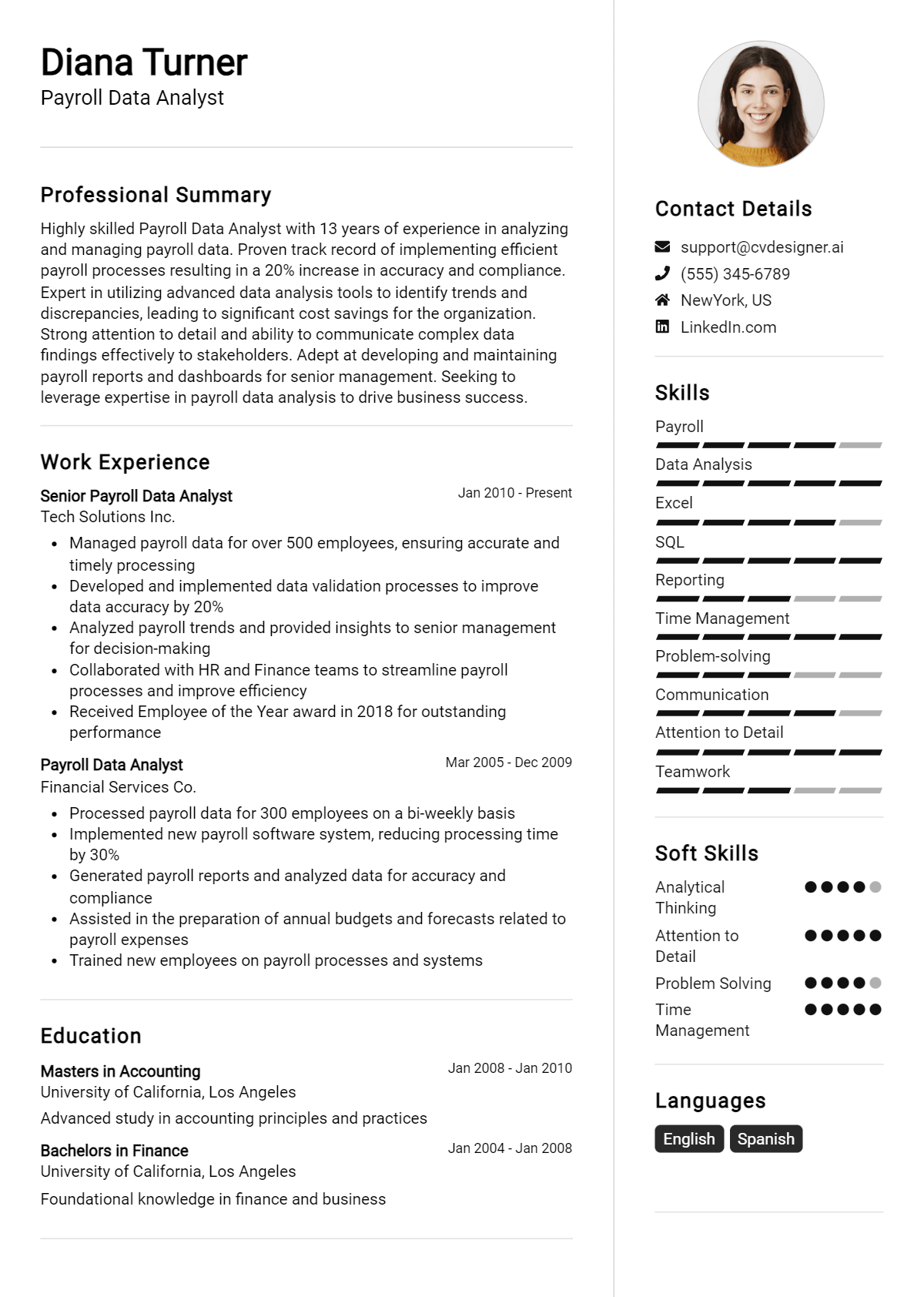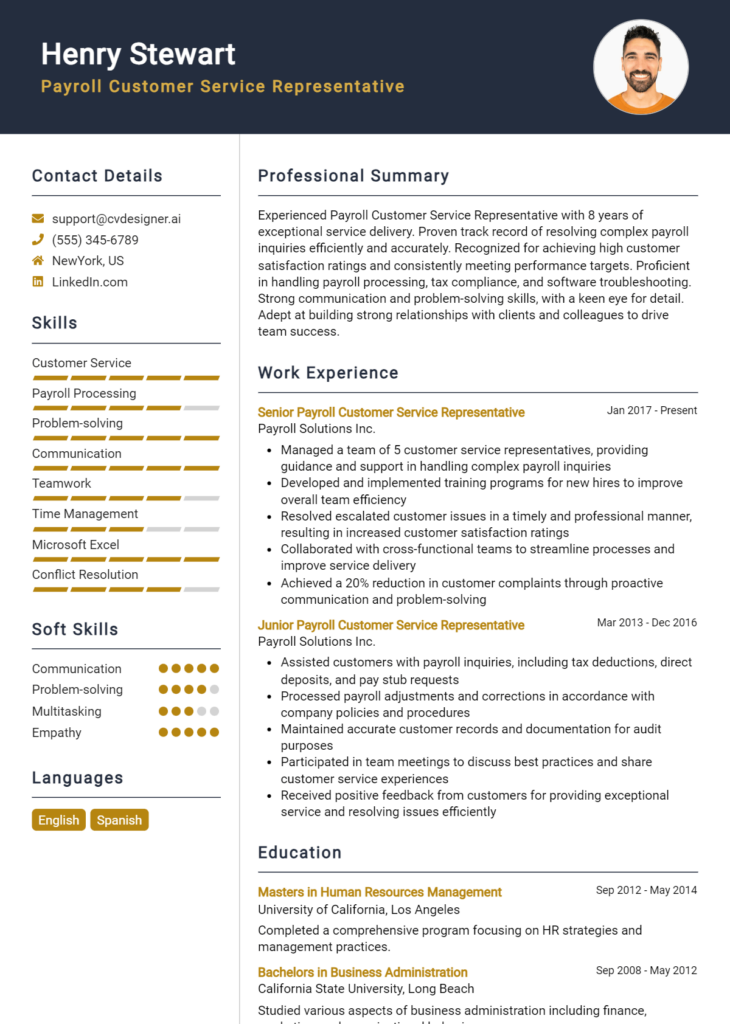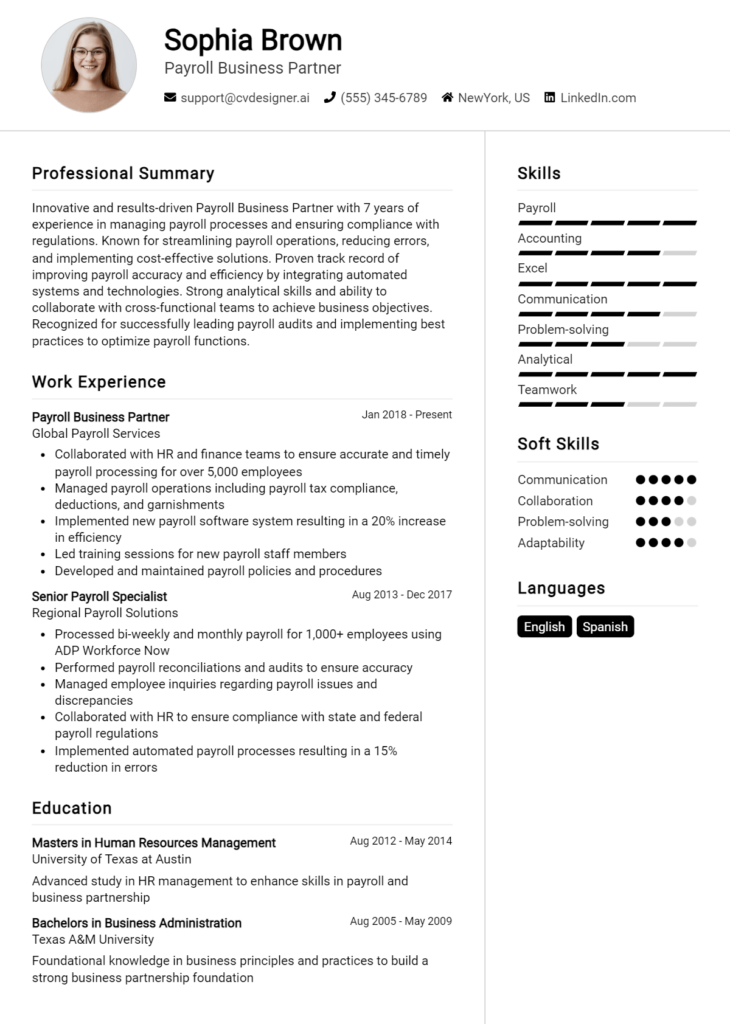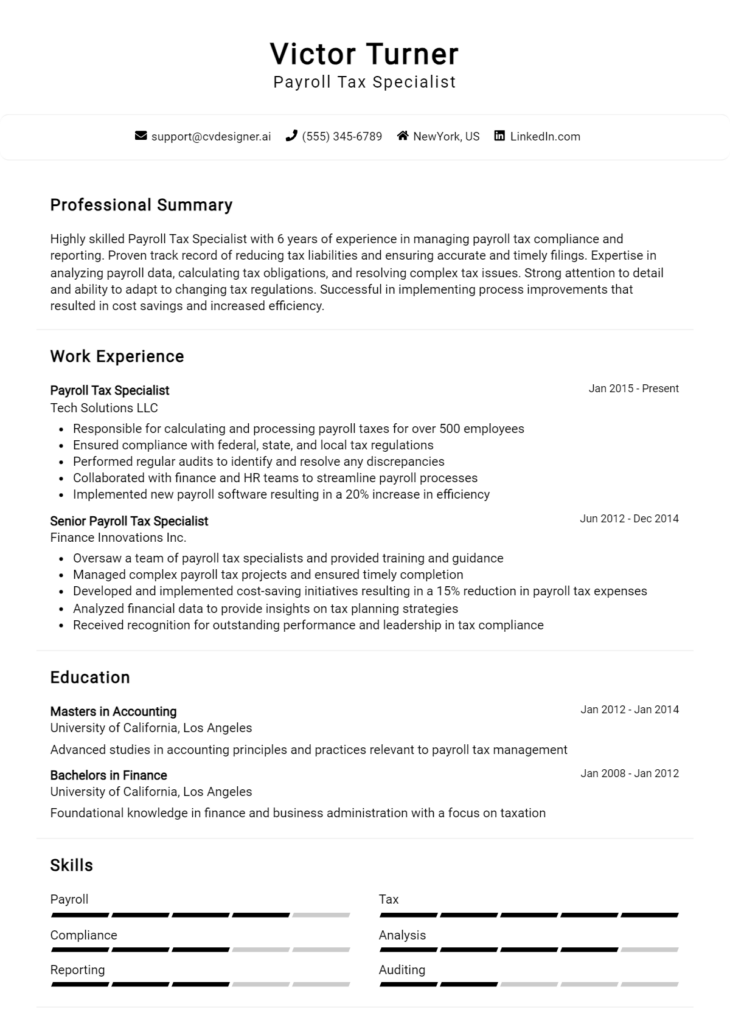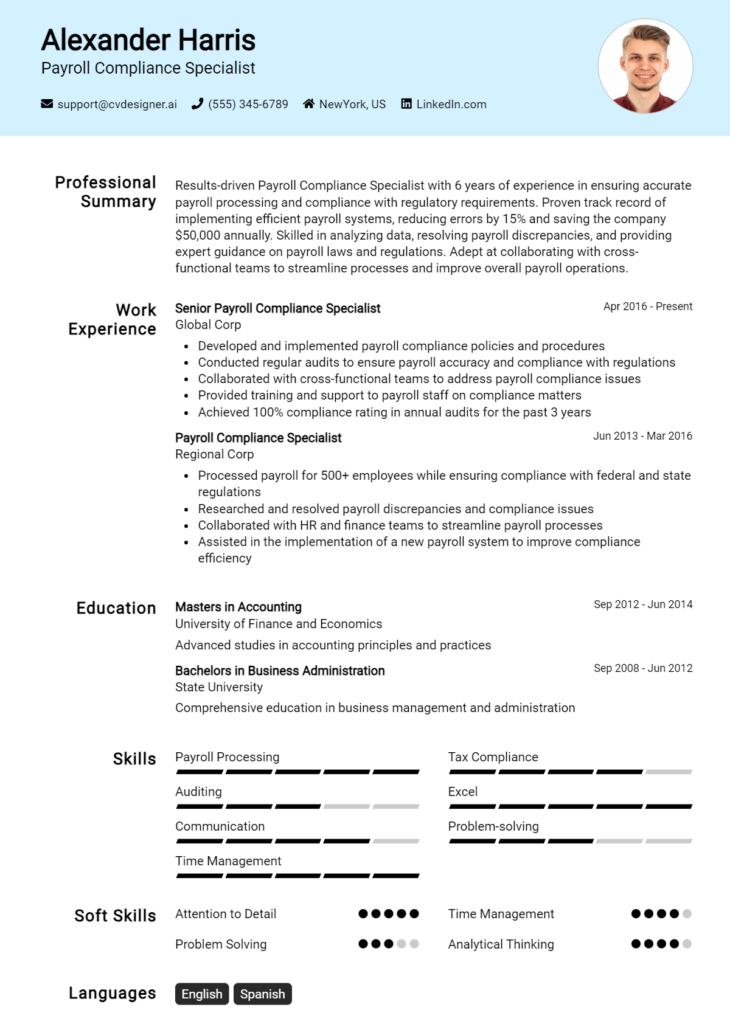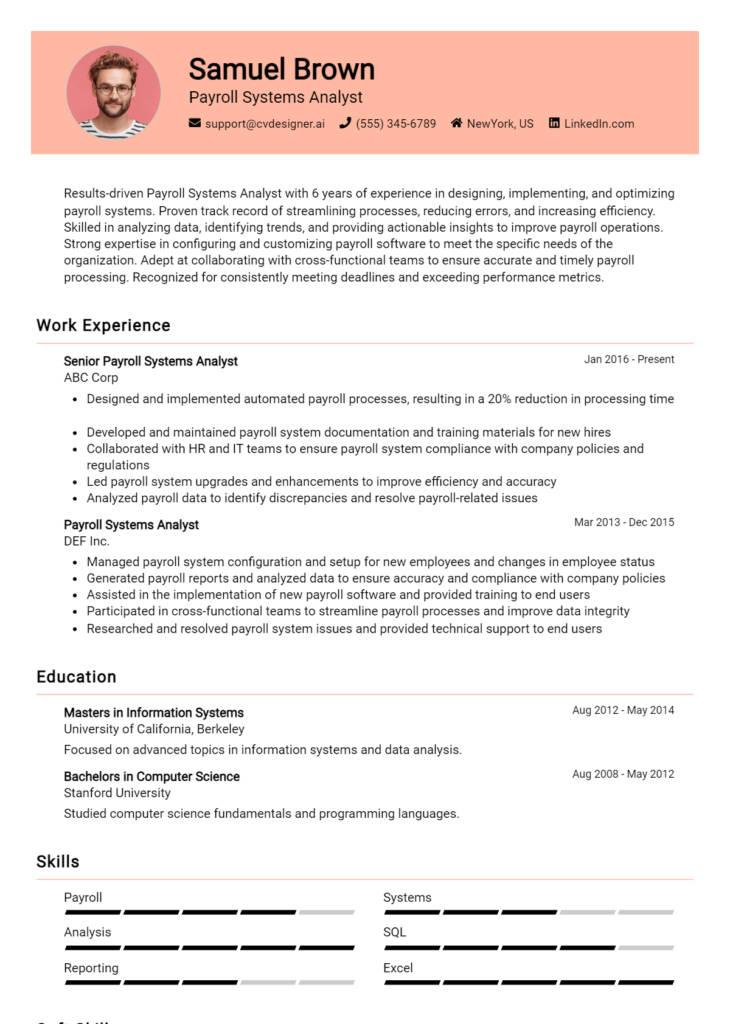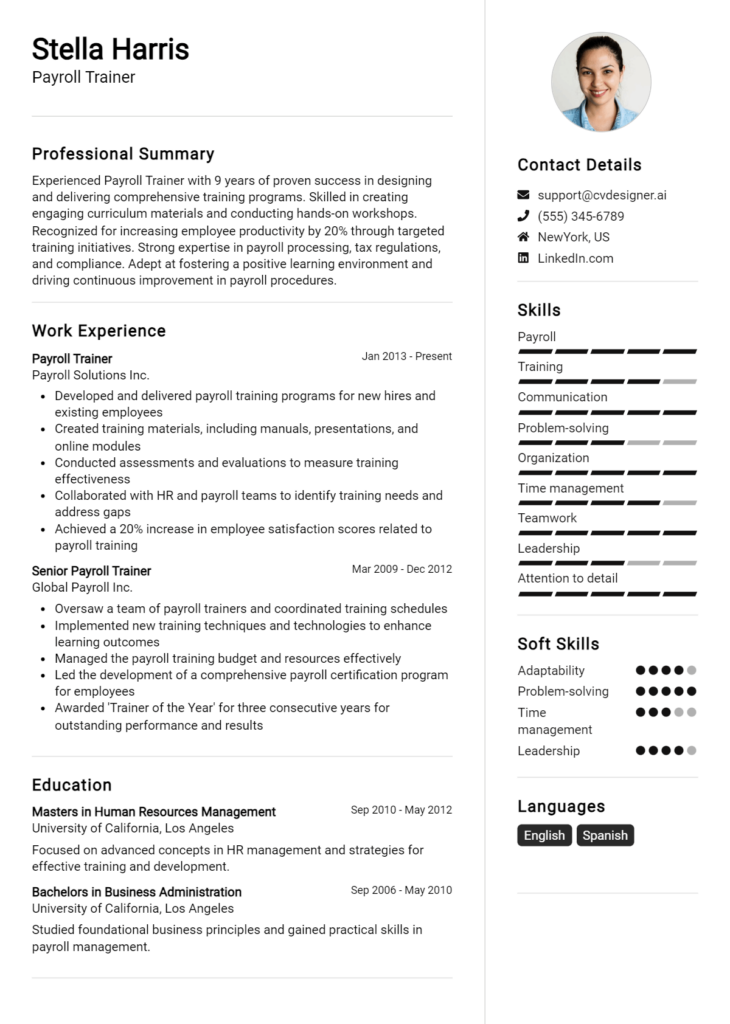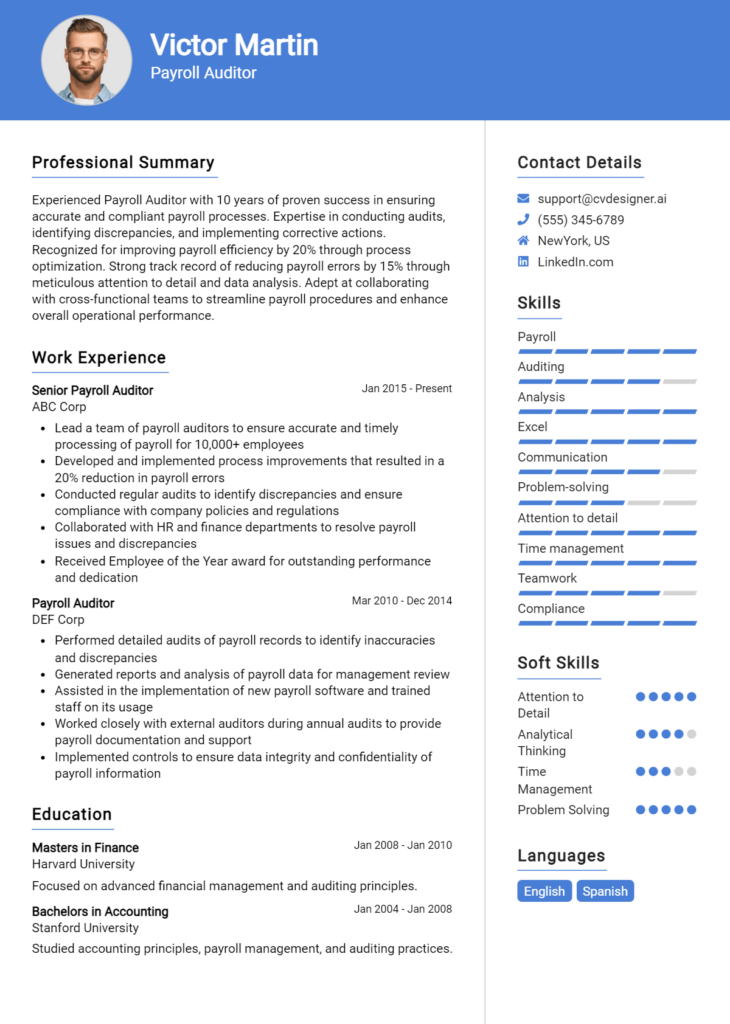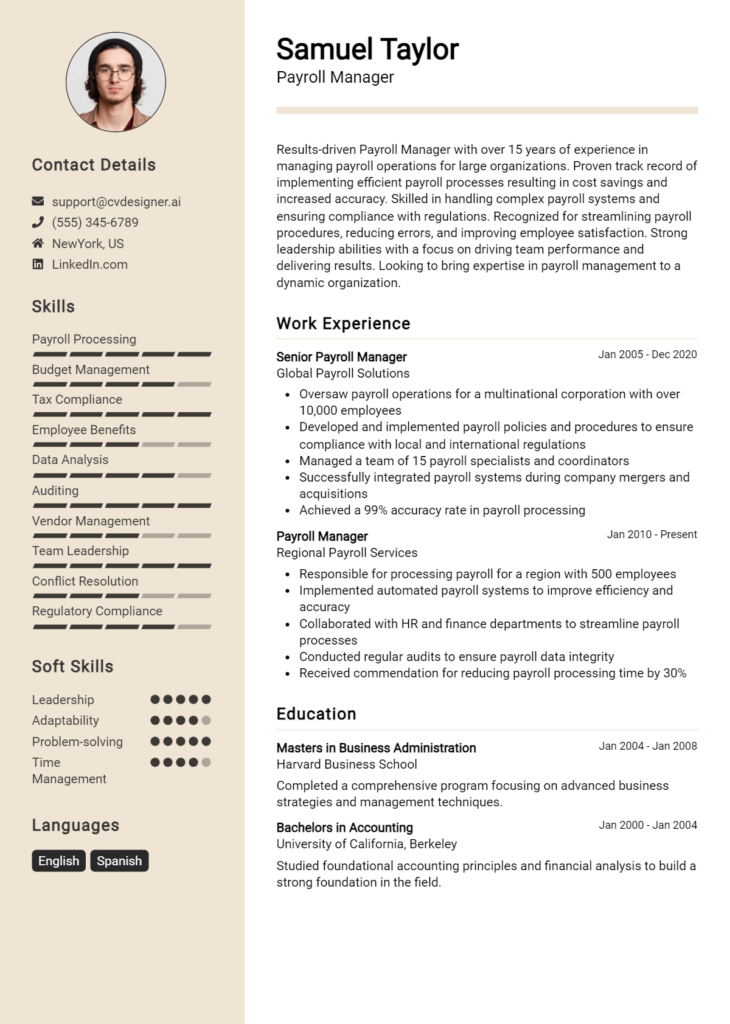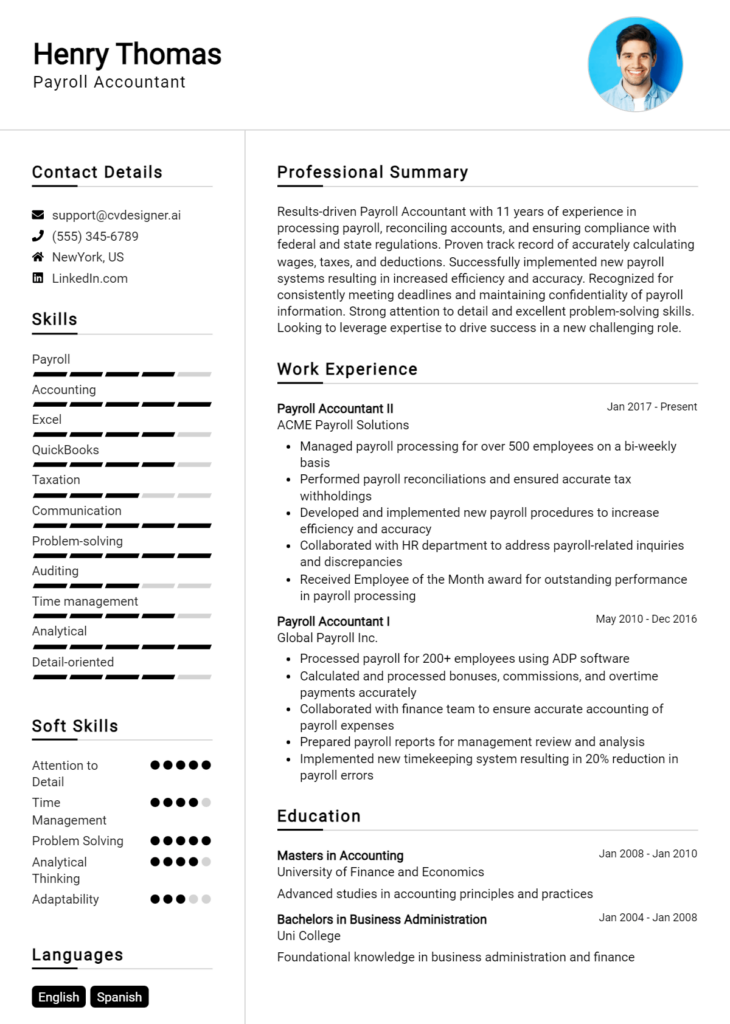Payroll Data Analyst Core Responsibilities
A Payroll Data Analyst plays a crucial role in ensuring accurate payroll processing and compliance within an organization. Key responsibilities include analyzing payroll data for discrepancies, preparing reports, and collaborating with HR and finance departments to streamline operations. Essential skills include technical proficiency in payroll software, strong analytical abilities, and excellent problem-solving capabilities. These skills contribute significantly to the organization’s goals by enhancing operational efficiency. A well-structured resume effectively highlights these qualifications, demonstrating the candidate's value to potential employers.
Common Responsibilities Listed on Payroll Data Analyst Resume
- Analyze payroll data to ensure accuracy and compliance.
- Prepare detailed payroll reports for management review.
- Collaborate with HR and finance teams to resolve payroll issues.
- Maintain payroll records, including employee data and tax information.
- Ensure compliance with federal, state, and local payroll regulations.
- Identify and implement process improvements in payroll operations.
- Conduct audits of payroll processes to ensure accuracy.
- Assist in the preparation of year-end payroll documentation.
- Support payroll system upgrades and testing as needed.
- Train and assist staff on payroll-related inquiries and systems.
- Monitor payroll-related metrics and provide insights for decision-making.
High-Level Resume Tips for Payroll Data Analyst Professionals
In today's competitive job market, a well-crafted resume is essential for Payroll Data Analyst professionals seeking to make a memorable first impression on potential employers. Your resume serves as your introduction, showcasing not only your skills and qualifications but also your achievements in the field. It is crucial to ensure that your resume effectively communicates your expertise in payroll management, data analysis, and compliance, as these are pivotal elements in this role. This guide will provide practical and actionable resume tips specifically tailored for Payroll Data Analyst professionals, helping you stand out among the competition.
Top Resume Tips for Payroll Data Analyst Professionals
- Tailor your resume to match the job description, using keywords and phrases from the posting.
- Highlight relevant experience in payroll processing, data analysis, and compliance in your work history.
- Quantify your achievements, such as percentage improvements in payroll accuracy or time saved in processing.
- Showcase industry-specific skills, such as familiarity with payroll software, tax regulations, and financial reporting.
- Include certifications or training related to payroll and data analysis to demonstrate your expertise.
- Use action verbs to convey impact, such as "analyzed," "optimized," or "streamlined."
- Keep your resume concise, ideally one page, focusing on the most relevant information.
- Incorporate soft skills such as attention to detail, problem-solving, and communication, as they are crucial in this role.
- Consider adding a summary statement that encapsulates your experience and goals as a Payroll Data Analyst.
- Proofread thoroughly to eliminate any errors, as accuracy is paramount in payroll-related roles.
By implementing these tips, you can significantly enhance your chances of landing a job in the Payroll Data Analyst field. A focused and polished resume will not only reflect your qualifications but also demonstrate your commitment to excellence in payroll management and data analysis, making you a standout candidate in the eyes of potential employers.
Why Resume Headlines & Titles are Important for Payroll Data Analyst
In the competitive field of payroll data analysis, a well-crafted resume headline or title serves as a crucial first impression for candidates seeking employment. It acts as an engaging hook, immediately grabbing the attention of hiring managers and summarizing a candidate's key qualifications in just a few impactful words. A strong headline should be concise, relevant, and directly aligned with the job being applied for, effectively communicating what the candidate brings to the table and setting the tone for the rest of the resume. By presenting a powerful headline, candidates can significantly enhance their chances of standing out in a crowded applicant pool.
Best Practices for Crafting Resume Headlines for Payroll Data Analyst
- Keep it concise: Aim for a headline that is brief yet informative, ideally one line.
- Be role-specific: Tailor your headline to reflect the specific position of Payroll Data Analyst.
- Highlight key skills: Incorporate relevant skills or certifications that distinguish you from other candidates.
- Use impactful language: Choose strong action verbs and descriptive adjectives that convey your expertise.
- Include quantifiable achievements: If possible, reference measurable successes to showcase your contributions.
- Avoid jargon: Use clear and straightforward language that can be easily understood by hiring managers.
- Stay relevant: Ensure your headline aligns with the job description and requirements of the position.
- Update regularly: Revise your headline for each application to reflect the specific role and company culture.
Example Resume Headlines for Payroll Data Analyst
Strong Resume Headlines
Detail-oriented Payroll Data Analyst with 5+ years of experience in optimizing payroll processes and ensuring compliance.
Results-driven Payroll Analyst skilled in data analysis, reporting, and implementing payroll solutions that reduce costs by 20%.
Experienced Payroll Data Specialist focused on leveraging advanced analytics to enhance payroll accuracy and efficiency.
Weak Resume Headlines
Payroll Analyst Seeking Job
Data Analyst with Experience
The strong headlines are effective because they convey a clear message about the candidate's qualifications, using specific language that highlights relevant skills and accomplishments. They paint a picture of a proactive and capable professional, drawing the reader in. In contrast, the weak headlines fail to impress as they are vague and generic, lacking any specific details that would differentiate the candidate from others. Such headlines do not provide any compelling reasons for hiring managers to consider the applicant further, making them easily forgettable in a sea of resumes.
Writing an Exceptional Payroll Data Analyst Resume Summary
A well-crafted resume summary is a critical component for a Payroll Data Analyst, as it serves as the first impression to hiring managers. This concise segment of the resume presents an opportunity to showcase key skills, relevant experience, and noteworthy accomplishments that align with the job's requirements. A strong summary quickly captures the attention of recruiters by delivering impactful information that highlights the candidate’s suitability for the role. It should be tailored to the specific job description, ensuring that it resonates with the employer's needs while remaining succinct and compelling.
Best Practices for Writing a Payroll Data Analyst Resume Summary
- Quantify Achievements: Include specific metrics to demonstrate your impact, such as percentage improvements in payroll accuracy or reductions in processing time.
- Focus on Key Skills: Highlight technical and analytical skills relevant to payroll processing, data analysis, and compliance.
- Customize for the Job: Tailor your summary to reflect the job description, using keywords and phrases that match the employer's requirements.
- Be Concise: Keep your summary brief, ideally between 2-4 sentences, to maintain the reader's attention.
- Showcase Relevant Experience: Mention previous roles or projects that directly relate to payroll data analysis.
- Use Action Verbs: Start sentences with strong action verbs to convey confidence and proactivity.
- Emphasize Compliance Knowledge: Highlight familiarity with payroll regulations and compliance standards to show your expertise in the field.
- Highlight Tools and Technologies: Mention any payroll software or tools you are proficient in, which are relevant to the role.
Example Payroll Data Analyst Resume Summaries
Strong Resume Summaries
Detail-oriented Payroll Data Analyst with over 5 years of experience optimizing payroll processes. Improved payroll accuracy by 30% through rigorous data validation and automation of reporting systems.
Analytical professional skilled in utilizing advanced Excel functions and payroll software to enhance data integrity. Reduced payroll processing time by 25% while ensuring compliance with federal and state regulations.
Results-driven Payroll Data Analyst with a proven track record of managing payroll for over 2,000 employees. Successfully led a project that decreased payroll discrepancies by 40% through meticulous audits and employee training.
Weak Resume Summaries
Experienced analyst looking for a payroll position. I have worked with data and numbers in the past.
Payroll Data Analyst with skills in various software. I am a quick learner and can adapt to new environments.
The strong resume summaries are considered effective because they are specific, quantify achievements, and directly relate to the responsibilities of a Payroll Data Analyst. They highlight relevant skills and experiences, providing concrete evidence of the candidate's capabilities. In contrast, the weak summaries lack detail and quantifiable outcomes, making them feel generic and uninspiring. They fail to convey the candidate's unique value or relevance to the position, which can lead to missed opportunities in the hiring process.
Work Experience Section for Payroll Data Analyst Resume
The work experience section of a Payroll Data Analyst resume is crucial as it serves as a platform to showcase the candidate's technical skills, leadership capabilities, and the ability to deliver high-quality results. This section provides potential employers with insights into the applicant's hands-on experience and accomplishments in the field. By quantifying achievements and aligning past experiences with industry standards, candidates can effectively demonstrate their value and expertise, making a compelling case for their candidacy.
Best Practices for Payroll Data Analyst Work Experience
- Highlight relevant technical skills, such as proficiency in payroll software and data analysis tools.
- Quantify achievements with specific metrics, such as percentage improvements in payroll accuracy or time saved in processing.
- Showcase experience in managing teams, emphasizing collaboration and leadership in projects.
- Align experiences with industry standards to demonstrate knowledge of best practices and compliance.
- Use action verbs to describe responsibilities and achievements, making the statements more impactful.
- Include examples of problem-solving and critical thinking in the context of payroll challenges.
- Tailor the work experience section to reflect the job description of the position being applied for.
- Incorporate feedback or recognition from previous employers to validate performance and contributions.
Example Work Experiences for Payroll Data Analyst
Strong Experiences
- Led a team that improved payroll processing time by 30% through the implementation of automated reporting tools, resulting in a significant reduction in manual errors.
- Analyzed payroll data to identify discrepancies, which resulted in a 15% increase in overall payroll accuracy over a 12-month period.
- Developed and maintained a comprehensive payroll dashboard that provided real-time insights to management, enhancing decision-making processes.
- Collaborated with HR and finance teams to streamline payroll systems, reducing costs by 20% while ensuring compliance with labor regulations.
Weak Experiences
- Worked on payroll tasks as assigned without clear outcomes or improvements.
- Assisted in data entry for payroll records without specifying the volume or impact of the work done.
- Participated in team meetings related to payroll processes but did not contribute significantly to discussions or outcomes.
- Handled payroll discrepancies occasionally, but did not provide details on resolution or results.
The examples provided highlight the importance of clarity and quantification in showcasing work experience. Strong experiences are characterized by specific metrics and achievements that demonstrate the candidate's impact on payroll processes, leadership, and collaboration. In contrast, weak experiences lack detail and do not convey the candidate's contributions effectively, making it difficult for potential employers to assess their value in a Payroll Data Analyst role.
Education and Certifications Section for Payroll Data Analyst Resume
The education and certifications section of a Payroll Data Analyst resume is crucial as it showcases a candidate's academic background, industry-relevant certifications, and commitment to continuous learning. This section serves to establish credibility and demonstrate alignment with the job role by highlighting relevant coursework, specialized training, and certifications that validate the candidate's expertise in payroll processes, data analysis, and compliance. A well-crafted education and certifications section can significantly enhance a candidate's chances of making a strong impression on potential employers.
Best Practices for Payroll Data Analyst Education and Certifications
- Prioritize relevant degrees in finance, accounting, or data analysis that align with payroll functions.
- List industry-recognized certifications such as Certified Payroll Professional (CPP) or Certified Management Accountant (CMA).
- Include any specialized training in payroll software or data analytics tools.
- Detail relevant coursework that emphasizes payroll laws, tax regulations, and data management.
- Highlight ongoing education or professional development courses to showcase a commitment to staying current.
- Ensure that all listed credentials are up-to-date and valid to maintain credibility.
- Use specific terminology and keywords from the job description to improve alignment with employer expectations.
- Organize the section clearly, using bullet points for easy readability and quick reference.
Example Education and Certifications for Payroll Data Analyst
Strong Examples
- Bachelor of Science in Accounting, University of XYZ, 2021
- Certified Payroll Professional (CPP), American Payroll Association, 2022
- Advanced Data Analytics Certificate, Online Learning Institute, 2023
- Relevant Coursework: Payroll Administration, Tax Compliance, Data Management Techniques
Weak Examples
- Bachelor of Arts in English Literature, University of ABC, 2019
- Certification in Basic Computer Skills, Online Course, 2020
- High School Diploma, City High School, 2015
- General Studies Coursework with no focus on payroll or data analysis
The strong examples are considered valuable because they directly relate to the responsibilities and skills required for a Payroll Data Analyst role, showcasing relevant degrees, certifications, and coursework. In contrast, the weak examples fail to demonstrate a connection to the field of payroll and data analysis, focusing instead on unrelated areas of study or outdated certifications. This stark difference highlights the importance of relevance and specificity in the education and certifications section.
Top Skills & Keywords for Payroll Data Analyst Resume
In the competitive field of payroll data analysis, possessing the right skills is crucial for standing out to potential employers. A well-crafted resume that highlights both hard and soft skills can significantly enhance your chances of securing a position. Hard skills demonstrate your technical expertise and proficiency in specific tools or methodologies essential for the role, while soft skills illustrate your interpersonal abilities and capacity to work collaboratively in a team environment. By effectively showcasing these skills on your resume, you provide a comprehensive view of your qualifications, making it easier for hiring managers to assess your fit for the role. For more guidance on how to optimize your resume, check out our detailed sections on skills and work experience.
Top Hard & Soft Skills for Payroll Data Analyst
Soft Skills
- Attention to Detail
- Analytical Thinking
- Problem-Solving
- Communication Skills
- Time Management
- Adaptability
- Team Collaboration
- Critical Thinking
- Organizational Skills
- Customer Service Orientation
Hard Skills
- Proficiency in Payroll Software (e.g., ADP, Paychex)
- Data Analysis and Reporting
- Excel (Advanced Functions and Formulas)
- Knowledge of Tax Regulations and Compliance
- Experience with Data Visualization Tools (e.g., Tableau)
- Familiarity with ERP Systems
- Statistical Analysis
- SQL Proficiency
- Understanding of Labor Laws
- Budgeting and Forecasting Skills
- Database Management
- Data Entry Accuracy
- Financial Reporting
- Knowledge of HR Systems
- Quality Assurance Procedures
- Familiarity with Automation Tools
Stand Out with a Winning Payroll Data Analyst Cover Letter
I am writing to express my interest in the Payroll Data Analyst position at [Company Name], as advertised on [Where You Found the Job Posting]. With a strong background in data analysis and payroll management, combined with my passion for optimizing processes, I am confident in my ability to contribute effectively to your team. I possess a keen eye for detail and a solid understanding of payroll systems, which I believe are crucial for ensuring accuracy and compliance in payroll operations.
In my previous role at [Previous Company Name], I successfully managed payroll data for over [Number] employees, implementing data-driven strategies that reduced payroll discrepancies by [Percentage] over a period of [Time Frame]. My experience with various payroll software, such as [Specific Software], allowed me to streamline processes, enhance reporting capabilities, and improve overall efficiency. I am adept at analyzing large datasets to identify trends and provide actionable insights that support decision-making. Additionally, my proficiency in Excel and SQL has enabled me to develop comprehensive reports that meet the needs of management and stakeholders.
I am particularly drawn to [Company Name] because of your commitment to innovation and excellence in payroll practices. I am eager to bring my analytical skills and dedication to quality to your team. I believe that my proactive approach and ability to collaborate with cross-functional teams will allow me to make a positive impact as a Payroll Data Analyst. I am excited about the opportunity to contribute to your organization and help enhance your payroll processes.
Thank you for considering my application. I look forward to the possibility of discussing how my skills and experiences align with the needs of your team. Please feel free to contact me at [Your Phone Number] or [Your Email Address] to arrange a conversation. I am enthusiastic about the opportunity to contribute to [Company Name] and advance my career in payroll data analysis.
Common Mistakes to Avoid in a Payroll Data Analyst Resume
When crafting a resume for a Payroll Data Analyst position, it's essential to showcase your skills and experience accurately. However, many candidates make mistakes that can undermine their chances of standing out to potential employers. By avoiding these common pitfalls, you can create a compelling resume that highlights your qualifications effectively. Here are several mistakes to watch out for:
Lack of Specificity: Failing to provide specific examples of your work can make your resume vague. Instead of saying you "managed payroll," specify how many employees you managed and the tools you used.
Ignoring Keywords: Many companies utilize applicant tracking systems (ATS) that search for specific keywords. Not including relevant terms related to payroll processing, data analysis, or compliance could result in your resume being overlooked.
Overloading with Jargon: While industry-specific terminology is essential, using too much jargon can confuse hiring managers. Ensure your resume balances technical terms with clear explanations of your accomplishments.
Neglecting Quantifiable Achievements: Listing responsibilities without quantifying achievements fails to demonstrate your impact. Use metrics and data to show how you improved payroll accuracy or streamlined processes.
Inconsistent Formatting: A cluttered or inconsistent format can detract from the professionalism of your resume. Use a uniform font, size, and layout to create a clean and organized appearance.
Focusing on Irrelevant Experience: Including unrelated work experience can dilute the focus of your resume. Tailor your content to emphasize experiences that directly relate to payroll and data analysis.
Not Showcasing Soft Skills: While technical skills are crucial, soft skills like communication and teamwork are equally important. Highlight your ability to collaborate with HR and finance teams to enhance payroll processes.
Forgetting to Proofread: Spelling and grammatical errors can create a negative impression. Always proofread your resume or have someone else review it to ensure it's polished and professional.
Conclusion
In conclusion, the role of a Payroll Data Analyst is crucial in ensuring the accuracy and efficiency of payroll processes within an organization. Key responsibilities include analyzing payroll data, identifying discrepancies, and providing insights that can lead to improved payroll strategies. It is essential for professionals in this field to possess strong analytical skills, attention to detail, and a solid understanding of payroll systems and regulations.
As you reflect on your qualifications and experiences, take a moment to review your resume. Tailoring your resume to highlight your relevant skills and accomplishments can make a significant difference in your job search. Consider utilizing helpful resources such as resume templates to structure your document effectively, a resume builder for ease of use, and resume examples to inspire your content. Additionally, don't overlook the importance of a well-crafted introduction with cover letter templates that can complement your resume.
Take action today and ensure your resume stands out in the competitive job market for Payroll Data Analysts!

